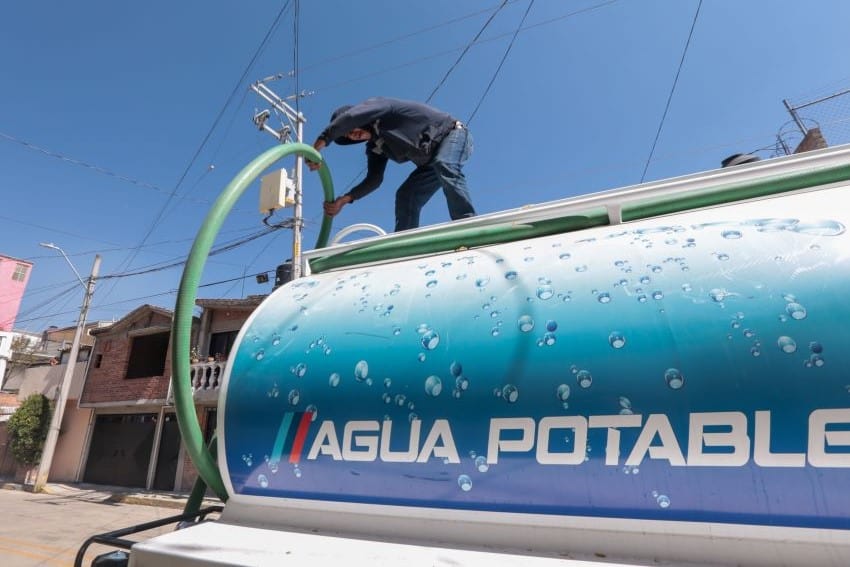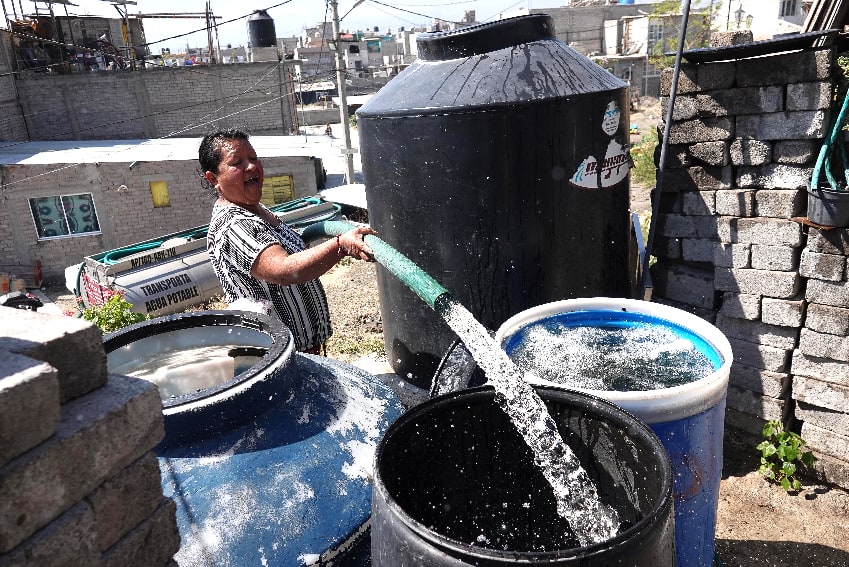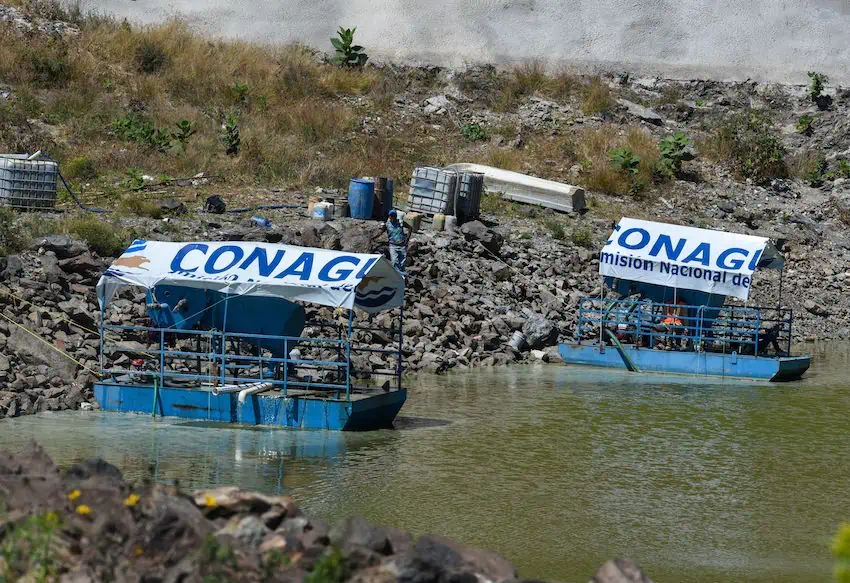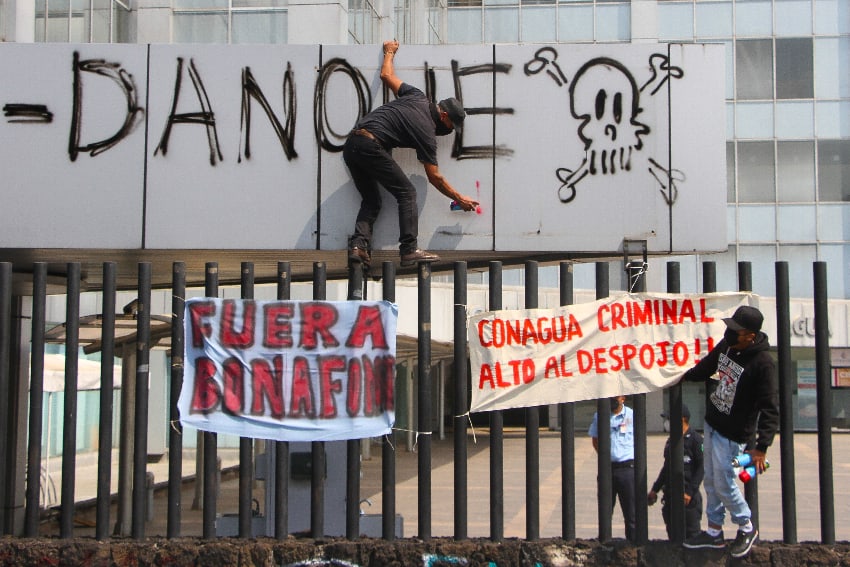Water permits under scrutiny as Mexico City faces water scarcity

Water supplies are dwindling in Mexico City. Many residents have limited or no access to running water. The capital’s primary water source could be depleted in 40 years. And at least 60 companies have permits that allow them to extract more than 1 million liters of water per day from the Valley of México’s water supply.
The news website Sin Embargo published a report on water scarcity this month that includes National Water Commission (Conagua) data on Mexico City water concessions held by companies including bottler Coca-Cola Femsa, broadcaster Televisa, brewer Grupo Modelo and manufacturer Procter & Gamble.
Those companies, and many others, use large quantities of water every day in Mexico City, and thus contribute in a significant way to the water scarcity problem faced by residents.
Now, at a time when Mexico City’s water shortage problem is growing more acute, civil society organizations, researchers and others say that things must change — and fast.
In addition to private companies’ substantial use of a resource that United Nations experts say should be managed as a common good rather than a commodity, low rainfall, leaky infrastructure, haphazard urban development and the high population of the greater Mexico City metropolitan area are among the factors that have caused and continue to contribute to water supply problems in the country’s capital and largest city.
Some of the lakes that supply the capital’s Cutzamala water supply system, such as the Valle de Bravo reservoir, are at critically low levels as drought continues to affect large parts of Mexico.
There has been speculation that a “day zero” — a day when Mexico City essentially runs out of water — is coming, perhaps even as soon as this June, but Mayor Martí Batres has denied that is the case.
Which companies hold large water use permits in Mexico City?
According to the Conagua data published by Sin Embargo, numerous Mexico City-based companies have concessions that allow them to extract hundreds of millions if not billions of liters of water per year. They include:
- Grupo Modelo — brewer of beers such as Corona, Modelo and Victoria — has had a concession since 1996 that allows it to use 8.09 billion liters of water per year, or almost 22 million liters per day.
- Embotelladora Mexicana de Bebidas Refrescantes — known commercially as Coca-Cola Femsa — was issued a permit in 2022 that allows it to use just under 1.3 billion liters of water per year, or 3.56 million liters per day.
- Procter & Gamble has had a concession since 1996 that allows it to use 1.16 billion liters of water per year, or 3.05 million liters per day.
- Colgate-Palmolive has had a permit since 1995 that allows it to use 893.7 million liters of water per year, or 2.44 million liters per day.
- Televisa, a large broadcaster that is currently redeveloping the Estadio Azteca (Aztec Stadium) in preparation for the 2026 FIFA men’s world cup, had had a concession since 2019 that allows it to use 450 million liters of water per year, or 1.23 million liters per day.
Several other bottling companies including Pepsi bottler Gepp hold rights to large annual water allocations as do a number of property development companies, ice producers and firms in a range of other sectors.

The National Autonomous University (UNAM) whose main campus is in southern Mexico City, is also a large water user. Since 1999, UNAM has had a concession that allows it to use 2.98 billion liters of water per year, or 8.16 million liters per day.
According to the Mexico City government, 10 companies and organizations including Coca-Cola Femsa, PepsiCo, Grupo Modelo, UNAM and Procter & Gamble hold permits for 48% of all water for which concessions have been issued in the capital.
Those companies last year committed to “donating” 7.7 million cubic meters of water (7.7 billion liters) per year to Mexico City residents, but that measure is unlikely to alleviate the capital’s water supply problem in any significant way.
“The water goes at midday and doesn’t come back until the next day”
While many companies have their own wells from which they extract huge quantities of water, Mexico City residents commonly face water shortages in their homes.
One such person is Alicia, a 52-year-old housewife who lives in the northern borough of Gustavo A. Madero. In her neighborhood, water pressure — when there is water — is low, and supply is limited to a few hours per day.
“The water goes at midday and doesn’t come back until the next day,” Alicia told Sin Embargo. “We have about five hours per day to collect it in buckets or the tank.”
The resident of the San Felipe de Jesús neighborhood believes that large companies “monopolize the city’s water,” a view shared by another Gustavo A. Madero local who spoke to Sin Embargo.
“We know they take the water, especially when they’re building shopping centers or buildings,” said Susana, a 50-year-old resident of the Tlalpexco neighborhood.

On the opposite side of Mexico City in the southern borough of Tlalpan, water shortages are also common.
Alejandro Gómez, a Tlalpan resident, “has been without proper running water for more than three months,” CNN reported in late February.
“Sometimes it comes on for an hour or two, but only a small trickle, barely enough to fill a couple of buckets. Then nothing for many days.”
Residents of many other boroughs in Mexico City endure similar situations. Buying water from trucks known as pipas to fill tanks is not a viable option for many of them due to the high cost.
How can Mexico City avoid a full-blown water crisis?
Experts from UNAM’s Water Network say that an investment of 97 billion pesos (US $5.8 billion) is needed over the next 15 years to avert a water crisis of unprecedented proportions in the Valley of Mexico.
In late February, they presented a report that underscored the criticality of addressing the impending exhaustion of the Mexico City aquifer.
The UNAM researchers’ water security plan includes intensive water capture, increased use of treated residual waters in agriculture and artificially recharging the aquifer by injecting surface water directly into the ground. Part of the recommended 97-billion-peso outlay would go to much-needed maintenance on the aging Cutzamala system.
“Specific actions are required for the next 15 years, for which 97 billion pesos are required to reverse the symptoms of water insecurity in the Valley of México,” said Marisa Mazari Hiriart, coordinator of the UNAM Seminar on Society, Environment, and Institutions.

Meanwhile, the three candidates vying to become the next mayor of Mexico City have presented their own plans to remedy water shortages in the capital.
Harvesting more rainwater, repairing leaky infrastructure and “rehabilitating” water sources are among their proposed actions.
The fight to make the distribution of water more equitable
“Companies think they own the water, that’s the case with Grupo Modelo, which is in [the Mexico City borough of] Miguel Hidalgo,” Ángel Martínez, a member of the non-governmental organization Agua Para Todos (Water for Everyone), told Sin Embargo.
“…There is also [bottled water company] Bonafont in Iztapalapa, where there has been subsidence in the area where it is located,” he said.
Agua Para Todos, other civil society groups, academics and many others are pushing for Mexico’s General Water Law to be changed in order to make the distribution of water more equitable in Mexico City, and across the country.
“The paradigm of water management has to change with a change in legislation that allows equitable access to water, that guarantees the human right to water [and] the sustainable and democratic management [of water],” Beatriz Romero, an academic and member of Agua Para Todos, said in a recent interview.
As things stand, “there is no guarantee of equitable access to water,” she said.
Large private concession holders have been given access to water in large volumes whereas water is rationed in small quantities to ordinary citizens, Romero said.

In consultation with researchers, Indigenous people, farmers, NGOs and others, Agua Para Todos developed 12 “consensuses” on which it believes a new General Water Law for the entire country should be based.
They include “closing the door on the privatization” of water, allowing citizens to “co-manage” water in the areas where they live and making the use of water to grow food a priority.
President López Obrador is also seeking to change Mexico’s existing water paradigm, and has recommended that companies seeking to open new plants in Mexico consider the country’s south, where water is more abundant.
One of 20 constitutional reform proposals he sent to Congress last month seeks to prohibit the granting of water concessions in areas where water is scarce, and to establish the precedence of the use of water for personal and domestic needs.
With reports from Sin Embargo
Source: Mexico News Daily

